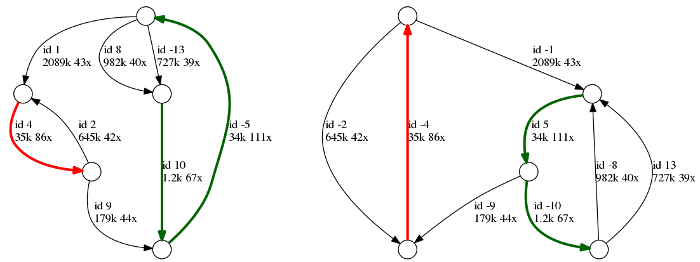Flye is a de novo assembler for single molecule sequencing reads, such as those produced by PacBio and Oxford Nanopore Technologies. It is designed for a wide range of datasets, from small bacterial projects to large mammalian-scale assemblies. The package represents a complete pipeline: it takes raw PacBio / ONT reads as input and outputs polished contigs. Flye also has a special mode for metagenome assembly.
- Fixes very long GFA generation time for some large assemblies (no other changes)
- Better assemblies of real (and comlpex) metagenomes
- New option to retain alternative haplotypes, rather than collapsing them (
--keep-haplotypes) - PacBio HiFi mode
- Using Bam instead of Sam to reduce storage requirements and IO load
- Improved human assemblies
- Annotation of alternative contigs
- Better polishing quality for the newest ONT datasets
- Trestle module is disabled by default (use
--trestleto enable) - Many big fixes and improvements
- This release introduces Python 3 support (no other changes)
- Better ONT polishing for the latest basecallers (Guppy/flipflop)
- Improved consensus quality of repetitive regions
- More contiguous assemblies of real metagenomes
- Improvements for human genome assemblies
- Various bugfixes and performance optimizations
- Also check the new FAQ section
Flye is using repeat graph as a core data structure. In difference to de Bruijn graphs (which require exact k-mer matches), repeat graphs are built using approximate sequence matches, and can tolerate higher noise of SMS reads.
The edges of repeat graph represent genomic sequence, and nodes define the junctions. Each edges is classified into unique or repetitive. The genome traverses the graph (in an unknown way), so as each unique edge appears exactly once in this traversal. Repeat graphs reveal the repeat structure of the genome, which helps to reconstruct an optimal assembly.
Above is an example of the repeat graph of a bacterial assembly. Each edge is labeled with its id, length and coverage. Repetitive edges are shown in color, and unique edges are black. Note that each edge is represented in two copies: forward and reverse complement (marked with +/- signs), therefore the entire genome is represented in two copies. This is necessary because the orientation of input reads is unknown.
In this example, there are two unresolved repeats: (i) a red repeat of multiplicity two and length 35k and (ii) a green repeat cluster of multiplicity three and length 34k - 36k. As the repeats remained unresolved, there are no reads in the dataset that cover those repeats in full. Five unique edges will correspond to five contigs in the final assembly.
Repeat graphs produced by Flye could be visualized using AGB or Bandage.
| Genome | Data | Asm.Size | NG50 | CPU time | RAM |
|---|---|---|---|---|---|
| E.coli | PB 50x | 4.6 Mb | 4.6 Mb | 2 h | 2 Gb |
| C.elegans | PB 40x | 102 Mb | 3.6 Mb | 100 h | 31 Gb |
| A.thaliana | PB 75x | 120 Mb | 9.5 Mb | 100 h | 46 Gb |
| D.melanogaster | ONT 30x | 139 Mb | 10.6 Mb | 130 h | 31 Gb |
| D.melanogaster | PB 120x | 142 Mb | 18.8 Mb | 150 h | 75 Gb |
| Human NA12878 | ONT 35x (rel6) | 2.9 Gb | 33.2 Mb | 2500 h | 714 Gb |
| Human CHM13 T2T | ONT 120x (rel3) | 2.9 Gb | 75.1 Mb | 5000 h | 871 Gb |
| Human HG002 | PB CCS 30x | 2.9 Gb | 27.5 Mb | 1400 h | 272 Gb |
| Human CHM1 | PB 100x | 2.8 Gb | 21.5 Mb | 2700 h | 676 Gb |
| HMP mock | PB meta 7 Gb | 66 Mb | 2.6 Mb | 60 h | 72 Gb |
| Zymo Even | ONT meta 14 Gb | 64 Mb | 0.6 Mb | 60 h | 129 Gb |
| Zymo Log | ONT meta 16 Gb | 23 Mb | 1.3 Mb | 100 h | 76 Gb |
The assemblies generated using Flye 2.7 could be downloaded from Zenodo.
All datasets were run with default parameters for the corresponding read type
with the following exceptions: CHM13 T2T was run with --min-overlap 10000 --asm-coverage 50;
CHM1 was run with --asm-coverage 40.
Flye package includes some third-party software:
Flye is distributed under a BSD license. See the LICENSE file for details.
Flye is developed in Pavel Pevzner's lab at UCSD
Code contributions:
- Repeat graph and current package maintaining: Mikhail Kolmogorov
- Trestle module and original polisher code: Jeffrey Yuan
- Original contig extension code: Yu Lin
- Short plasmids recovery module: Evgeny Polevikov
Mikhail Kolmogorov, Jeffrey Yuan, Yu Lin and Pavel Pevzner, "Assembly of Long Error-Prone Reads Using Repeat Graphs", Nature Biotechnology, 2019 doi:10.1038/s41587-019-0072-8
Yu Lin, Jeffrey Yuan, Mikhail Kolmogorov, Max W Shen, Mark Chaisson and Pavel Pevzner, "Assembly of Long Error-Prone Reads Using de Bruijn Graphs", PNAS, 2016 doi:10.1073/pnas.1604560113
A preferred way report any problems or ask questions about Flye is the issue tracker. Before posting an issue/question, consider to look through the FAQ and existing issues (opened and closed) - it is possble that your question has already been answered.
If you reporting a problem, please include the flye.log file and provide
details about your dataset.
In case you prefer personal communication, please contact Mikhail at fenderglass@gmail.com.

